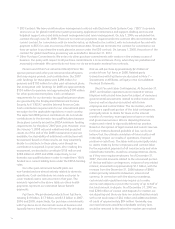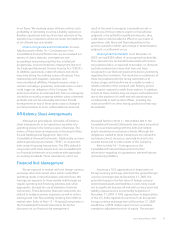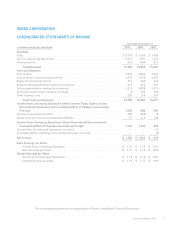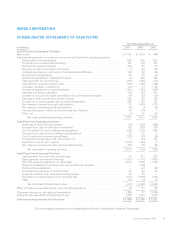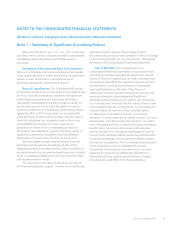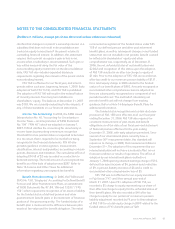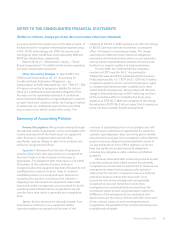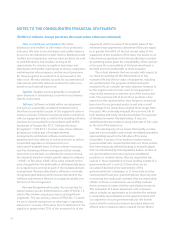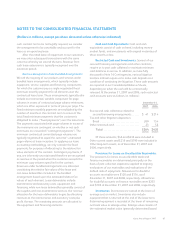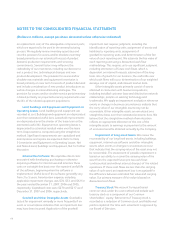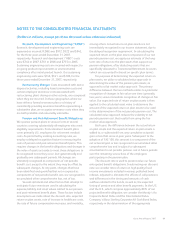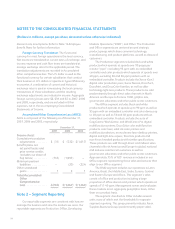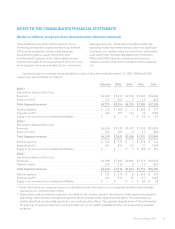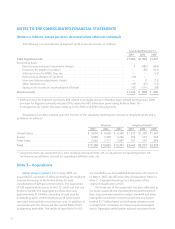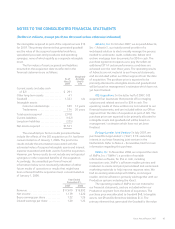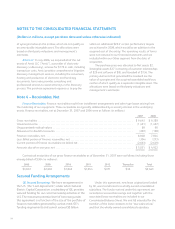Xerox 2007 Annual Report Download - page 86
Download and view the complete annual report
Please find page 86 of the 2007 Xerox annual report below. You can navigate through the pages in the report by either clicking on the pages listed below, or by using the keyword search tool below to find specific information within the annual report.
NOTES TO THE CONSOLIDATED FINANCIAL STATEMENTS
(Dollars in millions, except per-share data and unless otherwise indicated)
Fair Value Accounting: In 2006, the FASB issued
SFAS No. 157, “Fair Value Measurements” (“FAS 157”).
FAS 157 defines fair value, establishes a market-based
framework or hierarchy for measuring fair value, and
expands disclosures about fair value measurements. FAS
157 is applicable whenever another accounting
pronouncement requires or permits assets and liabilities to
be measured at fair value. FAS 157 does not expand or
require any new fair value measures, however the
application of this statement may change current practice.
The requirements of FAS 157 are first effective for our
fiscal year beginning January 1, 2008. However, in
February 2008 the FASB decided that an entity need not
apply this standard to nonfinancial assets and liabilities
that are recognized or disclosed at fair value in the
financial statements on a nonrecurring basis until the
subsequent year. Accordingly, our adoption of this
standard on January 1, 2008 is limited to financial assets
and liabilities, which primarily affects the valuation of our
derivative contracts. We do not believe the initial adoption
of FAS 157 will have a material effect on our financial
condition or results of operations. However, we are still in
the process of evaluating this standard with respect to its
effect on nonfinancial assets and liabilities and therefore
have not yet determined the impact that it will have on
our financial statements upon full adoption.
In February 2007, the FASB issued SFAS No. 159,
“The Fair Value Option for Financial Assets and Financial
Liabilities – Including an Amendment of FASB Statement
No. 115” (“FAS 159”). FAS 159 permits entities to choose
to measure many financial instruments and certain other
items at fair value. Entities that elect the fair value option
will report unrealized gains and losses in earnings at each
subsequent reporting date. The fair value option may be
elected on an instrument-by-instrument basis, with few
exceptions. FAS 159 also establishes presentation and
disclosure requirements to facilitate comparisons between
companies that choose different measurement attributes
for similar assets and liabilities. The requirements of FAS
159 are effective for our fiscal year beginning January 1,
2008. We do not believe that the adoption of this
statement will have a material effect on our financial
condition or results of operations as election of this option
for our financial instruments is expected to be limited.
Stock-Based Compensation: In 2004, the FASB
issued SFAS No. 123(R), “Share-Based Payment” (“FAS
123(R)”), which requires companies to recognize
compensation expense using a fair value based method
for costs related to all share-based payments, including
stock options. On January 1, 2006, we adopted FAS 123(R)
using the modified prospective transition method and
therefore we did not restate the results of prior periods.
Prior to the adoption of FAS 123(R), under previous
accounting guidance, we did not expense stock options, as
there was no intrinsic value associated with the options
granted because the exercise price was set equal to the
market price at the date of grant. The adoption of FAS
123(R) was immaterial to our results of operations
primarily as a result of changes made in our stock-based
compensation programs in 2005, including the
accelerated vesting of substantially all outstanding
unvested stock options prior to the adoption of FAS
123(R).
In 2005, we implemented changes in our stock-based
compensation programs that included expanded use of
restricted stock grants with time and performance-based
restrictions in lieu of stock options. Prior to this change, our
stock-based compensation programs primarily consisted
of stock option grants. These new restricted stock awards
are reflected as compensation expense in our results of
operations for all years presented and the adoption of FAS
123(R) did not materially affect the expense recognized
for these awards.
In 2005, we accelerated the vesting of approximately
3.6 million stock options granted in 2004 that would have
been scheduled to vest on January 1, 2007, to
December 31, 2005. The accelerated vesting resulted in
substantially all outstanding stock options being vested at
the date of the adoption of FAS 123(R). The primary
purpose of this accelerated vesting was to reduce our pre-
tax compensation expense in 2006 by approximately $31
or $0.02 per diluted share.
Stock-based compensation expense for the three
years ended December 31, 2007 was as follows (in
millions):
2007 2006 2005
Stock-based compensation expense,
pre-tax ......................... $89 $64 $40
Stock-based compensation expense,
netoftax ....................... 55 39 25
Prior to 2006, in accordance with previous accounting
guidance we did not recognize compensation expense
relating to employee stock options because the exercise
84


